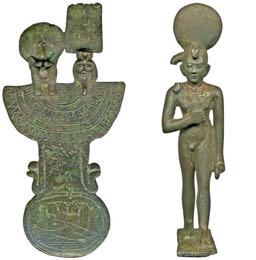

Through the presence of the creator god, a new system develops, which is totally different than preexistence. The sequence and nature of the steps in this development are different in each myth, but it can be assumed that, in the belief of the ancient Egyptians, first the gods and man were created and then – for them – space and time.
According to one of the predominant beliefs, which is already attested in the Coffin Texts of the Middle Kingdom around 2000 BC, mankind was created by the tears – and the gods from the sweat – of the god Atum. In other versions, living beings were modeled by Khnum (Fig. 13) on the potter’s wheel, or the gods were fabricated out of gold and humans from wood by Ptah.

Together, these two components create an atmosphere that enables the first appearance of the Creator as the sun god. In this atmosphere, space can now come into being, since it separates the sky (Nut) and the earth (Geb) from each other; these are also called the children of Shu and Tefnut. The sun god now becomes a cyclic god with distinct phases, with sunrise and sunset. He is presented as a young solar child or as a scarab god in the morning (Fig. 15) and an aging god in the evening (as Atum or Ra-Harakhte).

After the heavenly sphere, the earthly realm must be created. This task is the responsibility of the next generation of gods, who are described as the children of Geb and Nut (Fig. 16). These are the divine couples Osiris and Isis (Fig. 17), Seth and Nephthys. While Osiris at first represents the ordered, civilized world, Seth represents the wild, primeval forces of nature. Isis, the sister and wife of Osiris, embodies magic and the power of ritual, and Seth’s pendant Nephthys the sacred sphere.


In order to separate mankind from the gods, another disturbance of the system is necessary, of which is related in the Book of the Celestial Cow. This disruption is caused by the imperfect nature of man, who is incapable of recognizing that the phase of absence of the sun god and his form in old age are only temporary and therefore a normal part of the system. Mankind revolts against the sun god, who therefore wants to destroy them; to this end, he sends out his eye (in the form of the lioness-headed Tefnut or Sakhmet, Fig. 18). Their annihilation is, in the end, deterred through divine intervention, and they survive. Nevertheless, the sun now leaves mankind together with the gods and ascends permanently into the sky.

But one more disturbance is necessary, this time to effect the separation of this world from the hereafter. Osiris and Seth fight with each other in this world for power on earth, and Osiris is eventually conquered and killed. Here, too, the story derives from the observation of nature, especially the constant endangerment of farmlands by heat, drought and monsoon winds. Through the death of Osiris, the Netherworld – or the realm thereafter – is created. There, with the help of rituals performed by Isis and Nephthys, Osiris can be brought back to life as a ruler. His posthumously begotten son Horus (Fig. 19) takes his place as the rightful king in this world and acts as combatant against Seth; it is mandatory that Horus prevails in this conflict for the further development of the story.

This world and the Netherworld are just as much part of the Creation as heaven and earth. Osiris, as king of the realm of the dead, brings with him to the Netherworld his own skills in creating order and structure and ensures therewith the regeneration of humans and gods. But since Osiris, as a dead god, can no longer return to this world, his death marks the beginning of linear time. This path must reconnect with the cyclic time of the sun god every night anew; only in this way can death and renewal in this world and the next be guaranteed.
Only through confrontation with Osiris can the sun god be regenerated and reappear in the sky the next day. The dead in the Netherworld are also brought back to life through this confrontation and can continue to exist in the Netherworld as long as the Creation survives. Requisite for their continued existence, however, is that they successfully pass the Last Judgment of Osiris and are not destroyed by a corpse-devouring monster.

Even though Seth is perceived as an enemy of Osiris and Horus, he is still an important component of the Creation. Several cult centers were even established in his honor, particularly in Upper Egypt (such as in Ombos and Oxyrhynchus). Even some pharaohs were named after him, such as Sethos I (“the one Belonging to Seth”) or Sethnakht (“Seth is strong”). But beginning in the Third Intermediate Period in the first millennium BC, he became increasingly unpopular and eventually even demonized and regarded as an enemy of the gods. Still, he was never a serious threat to the perpetuity of Creation, since he was not an opponent of the sun god.
The situation is totally different, however, with a true enemy of Creation, who lurks in the Netherworld in anticipation of the sun god. This is the serpent or turtle god, Apophis [⇒7]. This being is not part of the Creation but belongs to the spaceless, timeless, formless regions outside of the created world. Every night he tries to stop the passage of the sun god by sucking up the water of the subterranean Nile or tries to swallow it. If he were to succeed, the continuous cycle of time would be interrupted, and the renewal of the god and Creation would no longer be possible. The cohesiveness of this world and the next would be destroyed, which would cause the end of the world.
| |
|
Regine C. Schulz: |
|
Contents
Presentation |